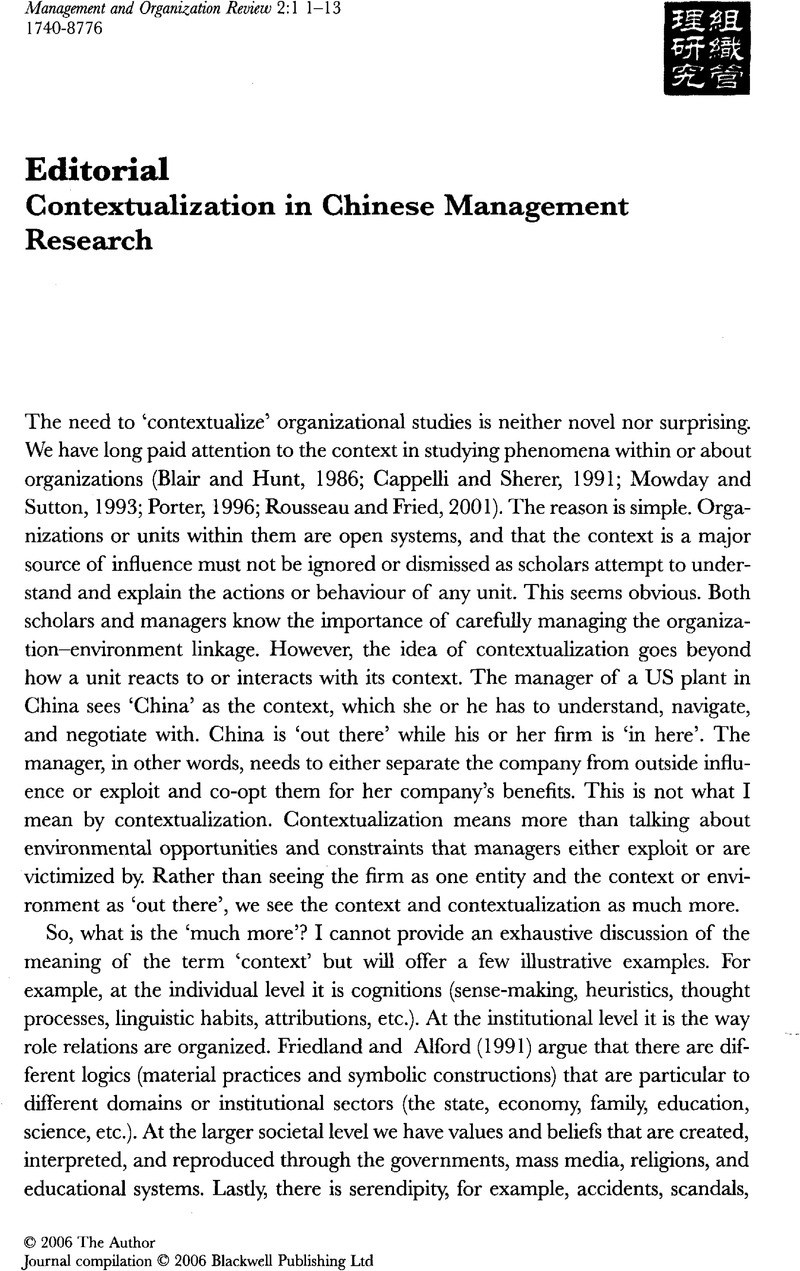Crossref Citations
This article has been cited by the following publications. This list is generated based on data provided by Crossref.
Farh, Jiing-Lih
Cannella, Albert A.
and
Lee, Cynthia
2006.
Approaches to Scale Development in Chinese Management Research.
Management and Organization Review,
Vol. 2,
Issue. 3,
p.
301.
Zhang, Kai
Song, Lynda Jiwen
Hackett, Rick D.
and
Bycio, Peter
2006.
Cultural Boundary of Expectancy Theory-Based Performance Management: A Commentary on DeNisi and Pritchard's Performance Improvement Model.
Management and Organization Review,
Vol. 2,
Issue. 2,
p.
279.
Farh, Jiing-Lih Larry
Cannella, Albert A. A.
and
Lee, Cynthia
2006.
Approaches to Scale Development in Chinese Management Research.
SSRN Electronic Journal,
Tsui, Anne S.
2007.
Taking Stock and Looking Ahead: MOR and Chinese Management Research.
Management and Organization Review,
Vol. 3,
Issue. 3,
p.
327.
Tsui, Anne S.
Zhao, Shuming
and
Abrahamson, Eric
2007.
What to Study in China? Choosing and Crafting Important Research Questions.
Management and Organization Review,
Vol. 3,
Issue. 2,
p.
171.
Peng, Mike W.
Zhang, Shujun
and
Li, Xinchun
2007.
CEO Duality and Firm Performance during China's Institutional Transitions.
Management and Organization Review,
Vol. 3,
Issue. 2,
p.
205.
Bruton, Garry D.
Dess, Gregory G.
and
Janney, Jay J.
2007.
Knowledge management in technology-focused firms in emerging economies: Caveats on capabilities, networks, and real options.
Asia Pacific Journal of Management,
Vol. 24,
Issue. 2,
p.
115.
Wang, Yue
and
Nicholas, Stephen
2007.
The formation and evolution of non-equity strategic alliances in China.
Asia Pacific Journal of Management,
Vol. 24,
Issue. 2,
p.
131.
Peng, Mike W.
2007.
Globalizing the Asia Pacific Journal of Management.
Asia Pacific Journal of Management,
Vol. 24,
Issue. 1,
p.
1.
Galaskiewicz, Joseph
2007.
Has a Network Theory of Organizational Behaviour Lived Up to its Promises?.
Management and Organization Review,
Vol. 3,
Issue. 1,
p.
1.
Shapiro, Debra L.
Glinow, Mary Ann Von
and
Xiao, Zhixing
2007.
Toward Polycontextually Sensitive Research Methods.
Management and Organization Review,
Vol. 3,
Issue. 1,
p.
129.
Tsui, Anne S.
2007.
From Homogenization to Pluralism: International Management Research in the Academy and Beyond.
Academy of Management Journal,
Vol. 50,
Issue. 6,
p.
1353.
Xiao, Zhixing
and
Tsui, Anne S.
2007.
When Brokers May Not Work: The Cultural Contingency of Social Capital in Chinese High-tech Firms.
Administrative Science Quarterly,
Vol. 52,
Issue. 1,
p.
1.
Tsui, Anne S.
Nifadkar, Sushil S.
and
Amy Yi Ou
2007.
Cross-National, Cross-Cultural Organizational Behavior Research: Advances, Gaps, and Recommendations.
Journal of Management,
Vol. 33,
Issue. 3,
p.
426.
Leung, Kwok
2007.
The Glory and Tyranny of Citation Impact: An East Asian Perspective.
Academy of Management Journal,
Vol. 50,
Issue. 3,
p.
510.
LIU, Jun
2008.
Antecedents of Employee Career Development: An Examination of Politics and Guanxi.
Acta Psychologica Sinica,
Vol. 40,
Issue. 2,
p.
201.
Zhu, Cherrie Jiuhua
Thomson, S. Bruce
and
Cieri, Helen De
2008.
A retrospective and prospective analysis of HRM research in Chinese firms: Implications and directions for future study.
Human Resource Management,
Vol. 47,
Issue. 1,
p.
133.
Chen, Zhen Xiong
Tsui, Anne S.
and
Zhong, Lifeng
2008.
Reactions to psychological contract breach: a dual perspective.
Journal of Organizational Behavior,
Vol. 29,
Issue. 5,
p.
527.
Horng, Ching
and
Chen, Wayne
2008.
From Contract Manufacturing to Own Brand Management: The Role of Learning and Cultural Heritage Identity.
Management and Organization Review,
Vol. 4,
Issue. 1,
p.
109.
Davison, Robert
Kien, Sia Siew
and
Ying, Dong Xiao
2008.
Introduction to the special issue on information systems in China.
Information Systems Journal,
Vol. 18,
Issue. 4,
p.
325.



